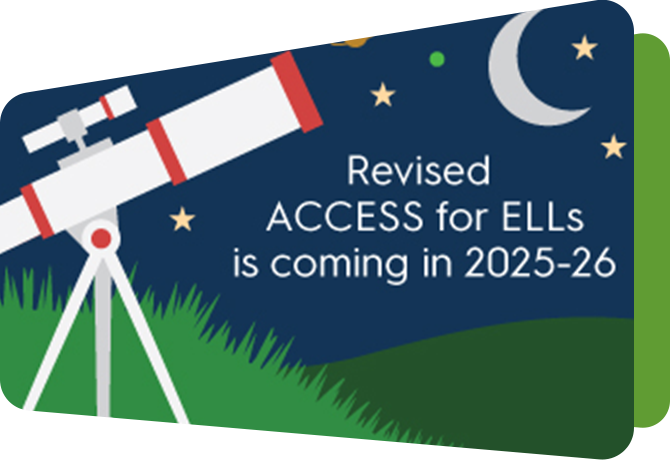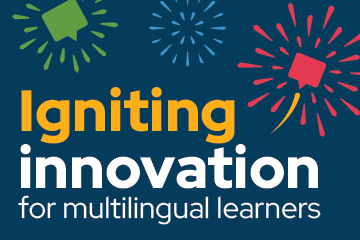Resources/Recursos
Featured Resources



All resources/Todos los recursos
Filter resources by:
Resources/Recursos
Universal Design for Learning Example Ideas Chart
This handout provides ideas for applying the Universal Design for Learning (UDL) framework in your classroom. It offers strategies to help all students, including multilingual learners with disabilities, participate in meaningful and challenging learning.
For more context around this resource, please visit the Supporting Multilingual Learners with Disabilities page.
Resource Details View Download NowReleased October 2025
Anchor Chart
This anchor chart highlights helpful words and math terms that students can use when explaining how to solve an equation in English. It includes sequence words, cardinal numbers, and math terms.
For additional context, including additional resources and videos, please visit the Standards in Action page.
Resource Details View Download NowReleased September 2025
A Framework for Understanding English Learners With Disabilities: Triple the Work
This ALTELLA Research Brief explains the Language and Disability Needs Framework. The brief focuses on considerations of students’ language-related and disability-related needs and their implications for instruction and assessment.
Resource DetailsReleased September 2025
Case Examples of English Learners With Significant Cognitive Disabilities
This ALTELLA Research Brief provides case examples of multilingual learners who have significant cognitive disabilities. The brief has five student examples: Sabeen (grade 1), Chung (grade 2), Chue (grade 4), Isabel (grade 6) and Luis (grade 10).
Resource DetailsReleased September 2025
Plan Curriculum, Instruction and Classroom Assessment With the WIDA Language Charts
This WIDA Snapshot provides guidance on how to use the WIDA Language Charts to collaborate and plan instruction.
Resource DetailsReleased August 2025
Examining English Learner Testing, Proficiency, and Growth: Continued Trends since the COVID-19 Pandemic
This report examines English learners’ testing, proficiency, and growth during the six most recent academic years (2018-2023) to shed light on the continued impact of the COVID-19 pandemic on English learners’ educational outcomes. It provides descriptive evidence on disparities in outcomes within WIDA's English learner population, with substantial average differences in outcomes between English learners identified as Hispanic compared to non-Hispanic ELs. Findings show that these disparities are persistent and have been exacerbated by the COVID-19 pandemic.
Published April 2024
Authors: Glenn Poole, Narek Sahakyan
Released April 2024
District Level Analysis of ELL Growth
This research project explored the patterns of district-level ELL “growth” for the 2007-2011 time period and identified the existence of “high-flying” and “low-cruising” districts within ACCESS for ELLs in terms of ELL growth.
Published May 2013
Author: Narek Sahakyan
Resource Details View Download Now
Released May 2023
Examining English Learner Testing, Proficiency, and Growth: Before, During, and “After” the COVID-19 Pandemic
This report examines English learner testing, proficiency, and growth in the years surrounding the COVID-19 pandemic. This research builds on an October 2021 report on the impact of the pandemic, and includes data from the 2021-22 ACCESS for ELLs test administration. Findings indicate that in some grades and language domains EL's average proficiency and growth have returned to pre-pandemic levels. However, for most grades and language domains the evidence points to a continuing impact of COVID-19 on English learners’ English language development.
Published April 2023
Author: Narek Sahakyan, Glenn Poole
Released April 2023
Examining Growth at the Intersection of IEP and (Long-Term) EL Status
Motivated by findings of a 2018 WIDA report pointing to large overlap between ELs with Individualized Education Program (IEP) designations and those ELs who could be identified as LTELs, this study further focuses on these dual-identified students. Grouping ELs by ever-IEP (i.e., being assigned an IEP at any point in the longitudinal record) and never-IEP status, we compare these two subgroups’ English language growth trajectories across time. Our findings show consistent trends of differential growth and reclassification rates for these two subgroups.
Published November 2021
Authors: Narek Sahakyan, Glenn Poole
Released November 2021
Examining English Learner Testing, Proficiency and Growth: Before and Throughout the COVID-19 Pandemic
This report examines English learners’ (EL) testing, proficiency and growth in the academic years of 2018–19, 2019–20 and 2020–21, using population-level data from ACCESS for ELLs Online, administered across the WIDA Consortium to students identified as ELs. The objective of the report is to shed light on the impact of the COVID-19 pandemic on ELs’ educational outcomes.
October 2021
Authors: Narek Sahakyan, H. Gary Cook
Released October 2021
Putting It All Together: Next Steps for Using the 2020 Edition
In this webinar, the WIDA standards development team discusses and models the tools, provided in the 2020 Edition, for initiating critical conversations with school leaders and colleagues.
Resource DetailsReleased March 2021
Curricular Considerations: Introduction to Collaborating Around the 2020 Edition
The WIDA ELD Standards Framework, 2020 Edition brings new practical ways for all educators working with multilingual learners to conceptualize the development of content and language together through asset-based, equitable, and rigorous approaches in curricular design. This session will encourage participants to think about what collaboration looks like in these contexts.
Resource DetailsReleased February 2021
Introduction to the Updated Key Language Uses
One of the components of the WIDA ELD Standards Framework is the Key Language Uses (KLUs). The KLUs summarize the most prominent language uses across disciplines, helping educators organize and prioritize curriculum and instruction. Learn about the updated KLUs – Inform, Narrate, Explain and Argue.
Resource DetailsReleased February 2021
Generating Imputed Overall Composite Scale Scores for English Learners with Disabilities Who Are Missing Domain Scores in the ACCESS for ELLs Assessment
This technical report aids WIDA Consortium members and stakeholders in producing imputed overall composite scale scores and proficiency levels for students who are missing scores in one or two domains due to a disability.
Published September 2020
Author: Narek Sahakyan
Released September 2020
Can Do Descriptors Student Name Charts, Kindergarten
This chart allows educators to track students by their level of English language proficiency.
Resource Details View Download NowReleased June 2020
Can Do Descriptors Student Name Charts, Grade 1
This chart allows educators to track students by their level of English language proficiency.
Resource Details View Download NowReleased April 2020
Can Do Descriptors Student Name Charts, Grades 2-3
This chart allows educators to track students by their level of English language proficiency.
Resource Details View Download NowReleased April 2020
Can Do Descriptors Student Name Charts, Grades 4-5
This chart allows educators to track students by their level of English language proficiency.
Resource Details View Download NowReleased April 2020
Can Do Descriptors Student Name Charts, Grades 6-8
This chart allows educators to track students by their level of English language proficiency.
Resource Details View Download NowReleased April 2020
Can Do Descriptors Student Name Charts, Grades 9-12
This chart allows educators to track students by their level of English language proficiency.
Resource Details View Download NowReleased April 2020




